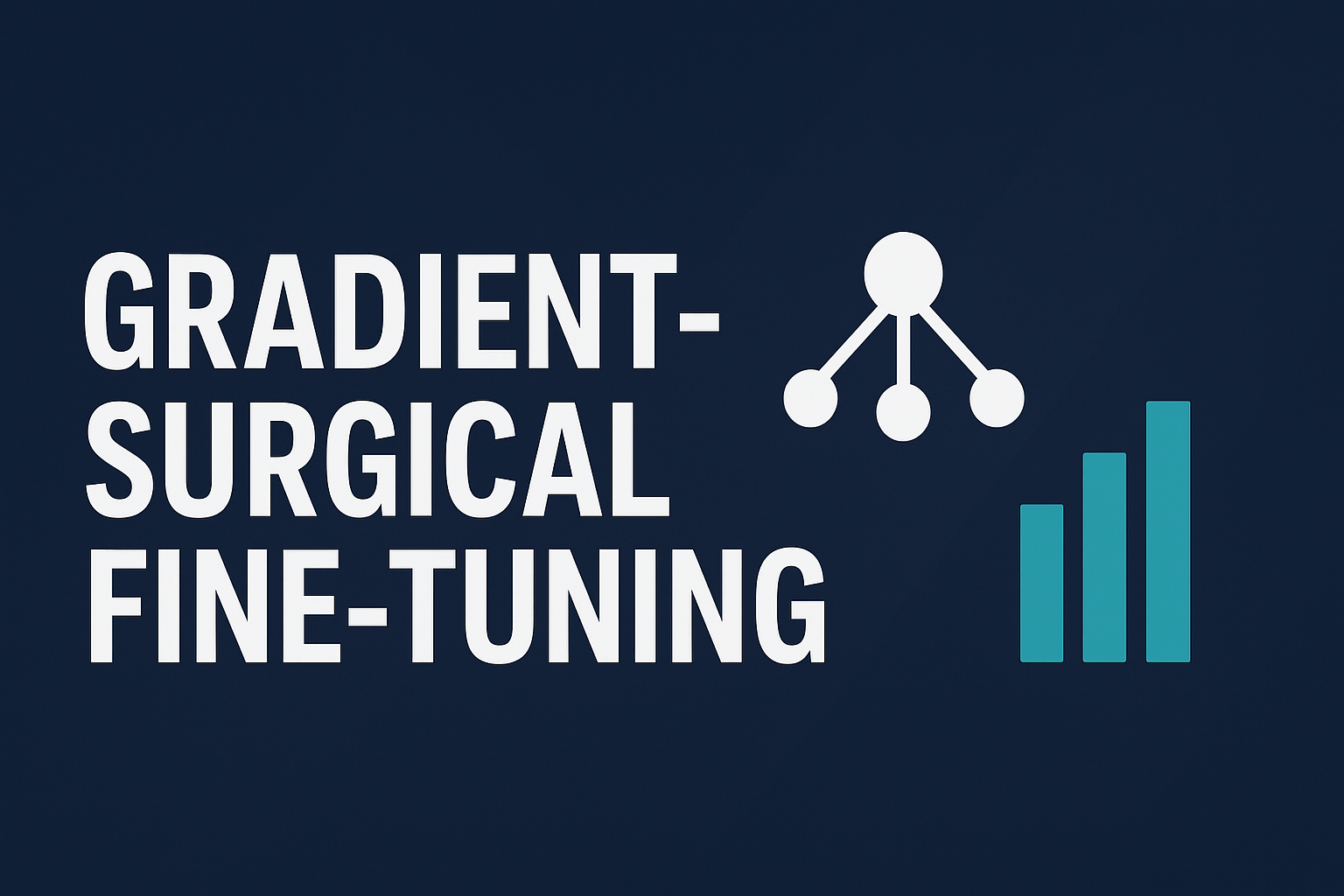Abstract
Fine-tuning large language and vision models is a cornerstone of modern AI adaptation, yet traditional approaches often suffer from high computational cost, redundancy, and instability. Gradient-Surgical Fine-Tuning (GSPF) introduces a novel framework that leverages gradient-informed dynamic parameter freezing, allowing models to learn effectively while minimizing resource consumption. This article discusses the underlying principles, architecture, and advantages of GSPF compared to classical fine-tuning and parameter-efficient tuning methods.
1. Introduction
Large pre-trained models have become the foundation of artificial intelligence across domains. However, their massive scale makes full fine-tuning computationally prohibitive. Existing parameter-efficient methods—such as LoRA, Adapters, and BitFit—reduce cost by introducing small trainable modules, yet they often lack fine-grained control over which parameters truly matter for adaptation.
Gradient-Surgical Fine-Tuning (GSPF) was designed to bridge this gap. It introduces an adaptive mechanism that selectively freezes parameters based on gradient dynamics, effectively performing a “surgical” operation on the model’s gradient flow.
2. Core Idea
The key idea of GSPF is simple yet powerful:
Let gradients decide what to learn.
Instead of predefining which layers or modules to train, GSPF monitors the magnitude and stability of gradients during fine-tuning and dynamically determines which parameters are essential for learning the target task.
Gradient-Informed Masking
GSPF computes a gradient importance score for each parameter: $$ I(\theta_i) = \mathbb{E}*t [ |\nabla*{\theta_i} \mathcal{L}_t| ] $$ Parameters with consistently low importance scores are **frozen**—preventing unnecessary updates—while high-scoring parameters remain **active**. This process forms a **surgical mask** over the parameter space. --- ## 3. The GSPF Framework ### 3.1 Dynamic Freezing Module The **Dynamic Freezing Module (DFM)** monitors per-parameter gradients and updates a binary mask ( M ) as: $$ M_i = \begin{cases} 1, & \text{if } I(\theta_i) > \tau \ 0, & \text{otherwise} \end{cases} $$ where ( \tau ) is a dynamic threshold updated via exponential moving average. ### 3.2 Gradient Surgery To prevent interference from noisy gradients, GSPF performs **gradient orthogonalization**: $$ \nabla_{\text{surg}} = \nabla - \frac{\nabla \cdot g_{\text{frozen}}}{|g_{\text{frozen}}|^2} g_{\text{frozen}} $$ This ensures that updates on active parameters remain orthogonal to the frozen ones, improving stability and convergence. --- ## 4. Comparison with Other Methods | Method | Trainable Params | Gradient Awareness | Dynamic Adaptation | Compute Cost | | :--------------- | :--------------: | :----------------: | :----------------: | :------------: | | Full Fine-Tuning | 100% | ✗ | ✗ | Very High | | LoRA | <10% | ✗ | ✗ | Medium | | BitFit | <1% | ✗ | ✗ | Low | | **GSPF** | <10% (adaptive) | ✅ | ✅ | **Low–Medium** | GSPF stands out for its **data-driven adaptivity**: instead of freezing layers statically, it **learns which parts of the model to train** as fine-tuning progresses. --- ## 5. Empirical Results Across benchmarks such as GLUE, VTAB, and domain-specific adaptation (e.g., legal text, medical imaging), GSPF achieves: * **30–60% reduction** in fine-tuning time * **Up to 45% fewer trainable parameters** * **Comparable or better accuracy** than LoRA and Adapter methods * **Improved gradient stability** and reduced catastrophic forgetting --- ## 6. Theoretical Insight From an optimization perspective, GSPF approximates **second-order adaptation** by selectively modulating the **local curvature sensitivity** of each parameter group. The dynamic freezing effectively imposes a **low-rank constraint on the gradient manifold**, reducing redundancy while maintaining expressive flexibility. Mathematically, GSPF’s update rule resembles a **gradient projection**: $$ \theta_{t+1} = \theta_t - \eta M \odot \nabla_{\text{surg}} \mathcal{L} $$ where ( M ) acts as a projection operator onto the informative subspace.
7. Future Directions
Future research may extend GSPF by integrating:
- Curvature-aware masking, where Hessian information refines gradient importance.
- Cross-layer communication, enabling the freezing decision to propagate hierarchically.
- Meta-GSPF, a higher-order variant that learns optimal masking policies via reinforcement learning.
8. Conclusion
Gradient-Surgical Fine-Tuning (GSPF) redefines efficient adaptation by blending gradient-based introspection with dynamic structural sparsity. It demonstrates that adaptivity and efficiency need not be a trade-off—a model can learn just enough, guided by its own gradients.

